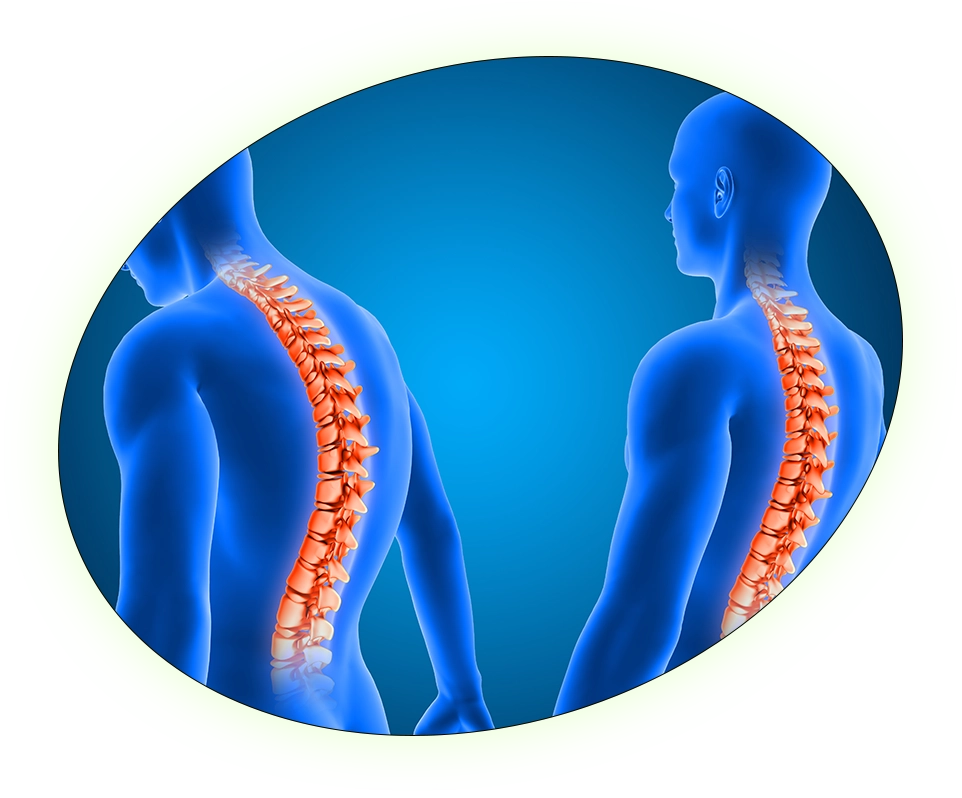Back and Spine Pain
Back and spine pain is more than just discomfort—it’s a major roadblock to mobility, productivity, and quality of life. Whether it’s a sharp jolt of pain, a dull ache, or stiffness that refuses to go away, back pain can hold you back from the activities you love.

Back pain can come from poor posture, spinal misalignment, injuries, or nerve compression. Sometimes, it’s as simple as bad ergonomics at work—other times, it’s a sign of a deeper issue like disc degeneration or arthritis.
Poor posture and prolonged sitting can weaken the spine, leading to back pain and discomfort. Additionally, muscle strain from improper lifting or sudden movements can cause injuries that impact mobility and daily activities.
Herniated Discs & Spinal Problems: Bulging discs pressing on nerves, causing radiating pain.
Sciatica & Nerve Compression: Pinched nerves triggering pain that shoots down the legs.
Arthritis and spinal degeneration cause gradual wear and tear, leading to chronic pain, stiffness, and reduced mobility over time.
Ignoring back pain can turn temporary discomfort into chronic suffering. If left untreated, it can cause nerve damage, mobility issues, and long-term spinal degeneration. Understanding the root cause of your pain is the first step toward reclaiming control over your body.
Back pain can become chronic if ignored, often caused by poor posture, weak core muscles, or nerve compression. Even sleep posture matters. Addressing it early helps prevent long-term issues.

Short-term pain may last days, but ignoring it can lead to long-term damage.

Slumping or poor ergonomics strain your back muscles.

It starts in the lower back, often caused by a compressed nerve.

Weak core muscles make your spine work harder, increasing pain.

A bad mattress or poor sleep posture can cause daily discomfort.

Can Prevent Long-Term Issues addressing pain now helps avoid future spine complications.
Back pain doesn’t happen overnight—it’s the result of habits, injuries, or underlying conditions:

Sitting all day without proper support strains the spine.

Lifting incorrectly or twisting the wrong way causes strain.

Bulging, herniated, or degenerating discs put pressure on nerves.

Pinched nerves radiate pain from the back to the legs.

Daily Struggles That Affect Your Well-Being
Back pain doesn’t just hurt—it limits how you move, work, and even sleep. If left untreated, it can lead to serious long-term mobility issues.
Stop letting back pain control your life. Act now to prevent long-term damage!
The Best Ways to Relieve and Prevent Back Pain

Adjust your desk, chair, and seating habits.

A strong core supports your spine and prevents strain.

Gentle movements keep your back pain-free.

A better mattress and temperature therapy can make a difference.

Persistent pain means it’s time to consult an expert.
Here are some of the questions that we are asked most frequently at Total Spine and Wellness
Regenerative medicine aims to replace damaged tissue or organs caused by factors like age, disease, trauma, or congenital issues, as opposed to focusing solely on symptom management. This is achieved through the use of tissue engineering, cellular therapies, medical devices, and artificial organs.
By combining these approaches, we can enhance our body’s natural healing process where it is most needed. Regenerative medicine brings together experts from various specialties who wish to be on the cutting edge of medicine.
When our bodies are injured or affected by disease, they possess an innate ability to heal and defend themselves. What if we could harness this inherent power and accelerate the healing process in a clinically relevant manner? What if we could aid the body in healing more effectively?
The promising field of regenerative medicine strives to restore the structure and function of damaged tissues and organs. It also aims to develop solutions for organs that have sustained permanent damage. Ultimately, the goal of regenerative medicine is to create transformative healthcare solutions that could potentially help injuries and diseases that were previously deemed untreatable.
Stem cells are undifferentiated cells in our bodies that have the remarkable ability to develop into various types of specialized cells. They can divide and renew themselves to form more stem cells or differentiate into specific cell types, such as muscle, nerve, or blood cells. Stem cells play a crucial role in the development, growth, and repair of tissues and organs in our bodies. They hold great potential for medical research and regenerative medicine, as they may be used to treat a wide range of diseases and injuries.
Stem cells have the remarkable ability to develop into different cell types in the body and can also repair damaged tissues. When introduced into a specific area, they can promote healing through various mechanisms. Stem cells can differentiate into the desired cell type, replacing damaged cells directly. They can also secrete growth factors and proteins that stimulate the surrounding cells to regenerate and repair themselves. Additionally, stem cells can modulate the immune response and reduce inflammation, creating a more favorable environment for healing. These combined effects make stem cells a valuable tool for treating degenerative conditions.
Mesenchymal stem cells (MSCs) are a promising source for the treatment of OA due to their multipotency for differentiation into chondrocytes and their ability to modulate the immune system.
These surgical procedures are considered part of a physician’s practice of medicine, allowing both the physician and patient to freely consider their preferred treatment options. While the FDA does provide guidelines for the treatment and manipulation of a patient’s own tissues, Total Spine adheres to these guidelines by offering same-day treatment using the patient’s unaltered cells, which are inserted during the procedure.
Not everyone is a good candidate for stem cell treatment. We offer a complimentary consultation and imaging review to determine if someone is likely to benefit from our treatments. If the severity of the condition is too great and a successful outcome is not likely, the patient will be told that in consultation.
We are a team of highly specialized spine surgeons dedicated to pioneering the future of spine care.